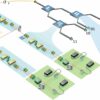An international research team from Innsbruck and Geneva has developed a new thermometry method to measure temperatures for low-dimensional quantum gases. With this method it was found that compressing a gas may lead to cooling. The results on this counterintuitive phenomenon have just been published in Science Advances.
Everyday experience tells us that compression heats, and expansion cools. Anybody who has pumped up a bicycle tire knows that. Enter quantum physics. In the quantum world, special rules apply. Particles known as bosons may jointly condense and become superfluid. Fermions exhibit the Pauli exclusion principle and will avoid each other.
In reduced dimensions, the situation becomes more tricky. The role of quantum fluctuations is enhanced, and bosons may fermionize when inter-particle interactions are very strong.
In view of this, quantum systems in reduced dimensionality have become a rich field of research. They are used as a platform for quantum simulation. In particular, one-dimensional (1D) quantum wires have attracted widespread attention in view of the ongoing miniaturization of electronic circuitry.
The experimental platform of cold atoms confined to tight light potentials is used to realize such quantum wires and to quantum-simulate the properties of electrons under strong confinement.
In a joint experimental and theoretical work, carried out in Innsbruck at the Department of Experimental Physics and in the Department of Quantum Matter Physics at the University of Geneva, it was found that a strongly interacting quantum many-body system can experience cooling when the dimensionality is reduced. A “quantum tire” might thus cool as it is pumped up.
This effect is contrary to expectations, and in fact it has not been proposed or foreseen in the literature. The observation became possible with the development of a thermometry method that combines experiment and theory and that works particularly well for the case of strong interactions.
“We are able to measure temperatures in 1D with one nano-Kelvin sensitivity,” says Yanliang Guo, one of the two lead authors of this study. “We find that the temperature first goes up from 12.5 nK to 17 nK when we compress from 3D to 2D, and then drops to 9 nK when we further compress to 1D.”
The cooling occurs because of the interplay of the strong lateral confinement in 1D and the strong interactions in the regime where the bosons fermionize. In the experiment, the team has checked that strong interactions in 1D are a necessary requirement for the cooling to happen.
“A change from 12.5 to 9 nK does not seem to be a lot,” says one of the team leaders Hanns-Christoph Nägerl. “But since the first results published now in this joint work, we have significantly improved and have seen temperatures down to 2 nK with 1-nK sensitivity.”
The team expects that these results will generate a lot of interest in the science community. Low-dimensional, strongly correlated quantum many-body systems feature a great variety of genuine quantum effects, and their investigation may shed light on many riddles in physics, the one of high-temperature superconductivity being the most prominent one, with far-reaching consequences if it were solved.
In particular, low-D systems of ultracold atoms are now widely used as a platform for quantum simulation, and a series of very interesting results has recently been obtained for systems in 1D (e.g., on prethermalization, dynamical fermionization, anomalous heat flow, spin-charge separation).
“Temperature plays a crucial role for all quantum systems, and hence being able to measure the temperature is of utmost importance,” says Hepeng Yao, the lead theorist on this study. “However, until now, this has not been done for isolated, strongly correlated 1D and 2D quantum many-body systems.”
Thierry Giamarchi, the team leader from Geneva, states, “Conceptually, we find it to be very interesting that temperatures may go down as the degree of confinement is increased. This is contrary to common intuition and shows the subtle effects that can occur in the quantum world.”
More information:
Yanliang Guo et al, Anomalous cooling of bosons by dimensional reduction, Science Advances (2024). DOI: 10.1126/sciadv.adk6870
Provided by
University of Innsbruck
Citation:
New thermometry method reveals that compressing a gas may lead to cooling (2024, February 15)



